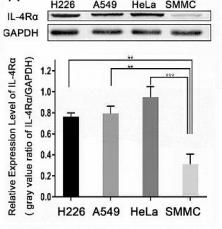IL4R/CD124 Antibody - #DF8567
| Product: | IL4R/CD124 Antibody |
| Catalog: | DF8567 |
| Description: | Rabbit polyclonal antibody to IL4R/CD124 |
| Application: | WB IHC IF/ICC |
| Reactivity: | Human, Mouse |
| Prediction: | Horse, Dog |
| Mol.Wt.: | 89 kDa; 90kD(Calculated). |
| Uniprot: | P24394 |
| RRID: | AB_2841771 |
Product Info
*The optimal dilutions should be determined by the end user.
*Tips:
WB: For western blot detection of denatured protein samples. IHC: For immunohistochemical detection of paraffin sections (IHC-p) or frozen sections (IHC-f) of tissue samples. IF/ICC: For immunofluorescence detection of cell samples. ELISA(peptide): For ELISA detection of antigenic peptide.
Cite Format: Affinity Biosciences Cat# DF8567, RRID:AB_2841771.
Fold/Unfold
CD124; IL 4R alpha; IL-4 receptor subunit alpha; IL-4-binding protein; IL-4R subunit alpha; IL-4R-alpha; IL-4RA; IL4-BP; Il4r; IL4R nirs variant 1; IL4RA; IL4RA_HUMAN; Interleukin 4 receptor alpha chain; Interleukin 4 receptor; sIL4Ralpha/prot; Soluble IL-4 receptor subunit alpha; Soluble IL-4R-alpha; Soluble interleukin-4 receptor subunit alpha;
Immunogens
- P24394 IL4RA_HUMAN:
- Protein BLAST With
- NCBI/
- ExPASy/
- Uniprot
MGWLCSGLLFPVSCLVLLQVASSGNMKVLQEPTCVSDYMSISTCEWKMNGPTNCSTELRLLYQLVFLLSEAHTCIPENNGGAGCVCHLLMDDVVSADNYTLDLWAGQQLLWKGSFKPSEHVKPRAPGNLTVHTNVSDTLLLTWSNPYPPDNYLYNHLTYAVNIWSENDPADFRIYNVTYLEPSLRIAASTLKSGISYRARVRAWAQCYNTTWSEWSPSTKWHNSYREPFEQHLLLGVSVSCIVILAVCLLCYVSITKIKKEWWDQIPNPARSRLVAIIIQDAQGSQWEKRSRGQEPAKCPHWKNCLTKLLPCFLEHNMKRDEDPHKAAKEMPFQGSGKSAWCPVEISKTVLWPESISVVRCVELFEAPVECEEEEEVEEEKGSFCASPESSRDDFQEGREGIVARLTESLFLDLLGEENGGFCQQDMGESCLLPPSGSTSAHMPWDEFPSAGPKEAPPWGKEQPLHLEPSPPASPTQSPDNLTCTETPLVIAGNPAYRSFSNSLSQSPCPRELGPDPLLARHLEEVEPEMPCVPQLSEPTTVPQPEPETWEQILRRNVLQHGAAAAPVSAPTSGYQEFVHAVEQGGTQASAVVGLGPPGEAGYKAFSSLLASSAVSPEKCGFGASSGEEGYKPFQDLIPGCPGDPAPVPVPLFTFGLDREPPRSPQSSHLPSSSPEHLGLEPGEKVEDMPKPPLPQEQATDPLVDSLGSGIVYSALTCHLCGHLKQCHGQEDGGQTPVMASPCCGCCCGDRSSPPTTPLRAPDPSPGGVPLEASLCPASLAPSGISEKSKSSSSFHPAPGNAQSSSQTPKIVNFVSVGPTYMRVS
Predictions
Score>80(red) has high confidence and is suggested to be used for WB detection. *The prediction model is mainly based on the alignment of immunogen sequences, the results are for reference only, not as the basis of quality assurance.
High(score>80) Medium(80>score>50) Low(score<50) No confidence
PTMs - P24394 As Substrate
| Site | PTM Type | Enzyme | Source |
|---|---|---|---|
| K192 | Ubiquitination | Uniprot | |
| S383 | Phosphorylation | Uniprot | |
| S387 | Phosphorylation | Uniprot | |
| S390 | Phosphorylation | Uniprot | |
| S391 | Phosphorylation | Uniprot | |
| S470 | Phosphorylation | Uniprot | |
| S474 | Phosphorylation | Uniprot | |
| T476 | Phosphorylation | Uniprot | |
| Y497 | Phosphorylation | Uniprot | |
| Y575 | Phosphorylation | Uniprot | |
| Y603 | Phosphorylation | Uniprot | |
| S616 | Phosphorylation | Uniprot | |
| Y631 | Phosphorylation | Uniprot | |
| Y713 | Phosphorylation | Uniprot | |
| S753 | Phosphorylation | Uniprot | |
| T756 | Phosphorylation | Uniprot | |
| S791 | Phosphorylation | Uniprot | |
| T820 | Phosphorylation | Uniprot | |
| Y821 | Phosphorylation | Uniprot |
Research Backgrounds
Receptor for both interleukin 4 and interleukin 13. Couples to the JAK1/2/3-STAT6 pathway. The IL4 response is involved in promoting Th2 differentiation. The IL4/IL13 responses are involved in regulating IgE production and, chemokine and mucus production at sites of allergic inflammation. In certain cell types, can signal through activation of insulin receptor substrates, IRS1/IRS2.
Soluble IL4R (sIL4R) inhibits IL4-mediated cell proliferation and IL5 up-regulation by T-cells.
On IL4 binding, phosphorylated on C-terminal tyrosine residues. Phosphorylation on any one of tyrosine residues, Tyr-575, Tyr-603 or Tyr-631, is required for STAT6-induced gene induction.
The soluble form (sIL4R/IL4BP) can also be produced by proteolytic cleavage at the cell surface (shedding) by a metalloproteinase.
Cell membrane>Single-pass type I membrane protein.
Secreted.
Isoform 1 and isoform 2 are highly expressed in activated T-cells.
The functional IL4 receptor is formed by initial binding of IL4 to IL4R. Subsequent recruitment to the complex of the common gamma chain, in immune cells, creates a type I receptor and, in non-immune cells, of IL13RA1 forms a type II receptor. IL4R can also interact with the IL13/IL13RA1 complex to form a similar type II receptor. Interacts with PIK3C3 (By similarity). Interacts with the SH2-containing phosphatases, PTPN6/SHIP1, PTPN11/SHIP2 and INPP5D/SHIP. Interacts with JAK1 through a Box 1-containing region; inhibited by SOCS5. Interacts with SOCS5; inhibits IL4 signaling (By similarity). Interacts with JAK3. Interacts with CLM1 (By similarity).
The extracellular domain represents the IL4 binding protein (IL4BP).
The WSXWS motif appears to be necessary for proper protein folding and thereby efficient intracellular transport and cell-surface receptor binding.
The box 1 motif is required for JAK interaction and/or activation.
Contains 1 copy of a cytoplasmic motif that is referred to as the immunoreceptor tyrosine-based inhibitor motif (ITIM). This motif is involved in modulation of cellular responses. The phosphorylated ITIM motif can bind the SH2 domain of several SH2-containing phosphatases.
Belongs to the type I cytokine receptor family. Type 4 subfamily.
Research Fields
· Environmental Information Processing > Signaling molecules and interaction > Cytokine-cytokine receptor interaction. (View pathway)
· Environmental Information Processing > Signal transduction > PI3K-Akt signaling pathway. (View pathway)
· Environmental Information Processing > Signal transduction > Jak-STAT signaling pathway. (View pathway)
· Human Diseases > Cancers: Overview > Pathways in cancer. (View pathway)
· Human Diseases > Immune diseases > Inflammatory bowel disease (IBD).
· Organismal Systems > Immune system > Hematopoietic cell lineage. (View pathway)
· Organismal Systems > Immune system > Th1 and Th2 cell differentiation. (View pathway)
· Organismal Systems > Immune system > Th17 cell differentiation. (View pathway)
References
Application: WB Species: human Sample: tumor cell
Restrictive clause
Affinity Biosciences tests all products strictly. Citations are provided as a resource for additional applications that have not been validated by Affinity Biosciences. Please choose the appropriate format for each application and consult Materials and Methods sections for additional details about the use of any product in these publications.
For Research Use Only.
Not for use in diagnostic or therapeutic procedures. Not for resale. Not for distribution without written consent. Affinity Biosciences will not be held responsible for patent infringement or other violations that may occur with the use of our products. Affinity Biosciences, Affinity Biosciences Logo and all other trademarks are the property of Affinity Biosciences LTD.

